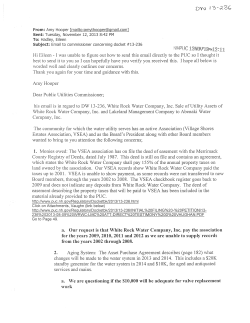
Syllabus - Department of History
HIS 2134B: “Talkin’ ’Bout My Generation”: Youth, Rebellion and Rock ’n’ Roll Department of History The University of Western Ontario Winter 2016 Instructor: Geoffrey Stewart Office Hours: Wednesdays 12:00 to 2:00 or by appointment Phone: 519-661-2111 ext. 84992 e-mail: gstewa4@uwo.ca Office: 2237 Lawson Hall The midpoint of the twentieth century ushered in a period of tremendous social and political upheaval across the globe. Geopolitically, the developed world was entering the ideological contest of the Cold War, while the less-developed states were attempting to throw off the shackles of the old imperial order. The Western world, particularly the United States, was entering a period of unprecedented affluence. On the surface, people appeared to be conforming to the banal norms of middle class life, enjoying stability after the dislocations of two world wars and a global depression. Scratch the surface and there was danger lurking. Many groups were marginalized and felt alienated from mainstream values. Slowly they began to push back, demanding an end to racial discrimination, more social justice, sexual freedom and gender equality. The resistance grew and turned to rebellion. At the vanguard of this rebellion was youth. In both the developed and underdeveloped world, younger generations were looking at the world their parents had sanctioned and demanded change. Rock’n’roll, in all its glory, emerged in this matrix, reflecting and shaping the societal changes that were at work. To the gatekeepers of social and political order, the sight, sound and spectacle of rock’n’roll epitomized the forces of rebellion they were attempting to keep at bay. For those who challenged that order rock’n’roll served as an anthem. This course uses the cultural phenomenon of rock’n’roll as a lens to explore the connections between youth and rebellion and societal change in the latter half of the twentieth century. In cultural terms, rock’n’roll transcended race, class, gender, sexual and national boundaries—a quality which lent it such symbolic and, at times, transformative power. It is with this cultural dimension that this course primarily concerns itself, treating the spectacle of the performers and the lyrics of their songs as historical texts that reflect the broader political, social and economic change that has defined the human condition. Beginning with the birth of the blues in the Mississippi Delta, where newly freed African-Americans would use the music as a powerful, and sometimes cathartic, outlet for the frustrations and hardships they faced on a daily basis, we will follow the relationship between rock’n’roll and societal change in both the United States and across the globe through subsequent generations as the culture of rock’n’roll—its sights, sounds and spectacle—served as a locus for resistance and rebellion to everything from parents Page 2 of 6 to politics. Outcomes: Upon completing the course, students will be able to: • Identify and describe key figures, movements, events and trends that have shaped the second half of the twentieth century • Discuss, from a historical perspective, the connections between rock’n’roll race, class, gender, sexual and national identity • Critically assess the connection between rock’n’roll and societal change through examinations, class discussions and a written assignment • Develop verbal and written communication skills • Consider the strengths and weaknesses of music as a historical source Possible Textbooks: Brian Cogan and Thom Gencarelli, Baby Boomers and Popular Culture: An Inquiry into America’s Most Powerful Generation (Santa Barbara, CA: Praeger, 2014) Keith Richards, Life (New York: Little, Brown & Co., 2010) Deena Weinstein, Rock’n America: A Social and Cultural History (Toronto, ON: University of Toronto Press, 2015) Course Requirements: Midterm Exam 30% (February 9) The Cover of the Rolling Stone Assignment 30% (Due March 15) Final Exam 40% (Final Exam Period) Midterm and Final Exam: There will be one Midterm exam held in class on February 9 and a Final exam held during the Spring Exam period. Electronic devices are not permitted in either exam. Page 3 of 6 Cover of the Rolling Stone: In the very first edition of Rolling Stone, founder and publisher Jann Wenner explicitly stated the magazine “is not just about the music, but about the things and attitudes that music embraces.” This assignment gives you the opportunity to realize that vision. You will be required to write a 6 page (double-spaced) article for Rolling Stone magazine discussing how the culture of rock’n’roll—its sight, sound or spectacle—as reflected in an artist, a band, a song, or an album commented on, furthered or symbolized the societal change of that particular era. Your article should use a minimum of five secondary sources (books, monographs, journal articles) from the Weldon Library including at least one journal article and book. On-line material is acceptable only in certain cases which must be verified by the professor or Teaching Assistant. All citations should appear as footnotes or endnotes and follow Chicago Style in format. The article will be due in class* on March 15. *Assignment Submission Hardcopies of all assignments are to be submitted in class as well as electronically to turnitin.com by the time that class has started. “Students agree that by taking this course all required papers may be subject to submission for textual similarity review to Turnitin.com for the detection of plagiarism. All submitted papers will be included as source documents in the Turnitin.com reference database solely for the purpose of detecting plagiarism of such papers. The terms that apply to the University’s use of the Turnitin.com service are described on the Turnitin.com website.” Late assignments will be penalized 5% the first day and 2% each subsequent day. Late assignments handed in after the last day of class will not be accepted. Students must complete this assignment to pass the course. Page 4 of 6 Statement on Plagiarism: It shall be an offence for a student to commit plagiarism. From the Academic Handbook: Plagiarism: “The act or an instance of copying or stealing another’s words or ideas and attributing them as one’s own.” Excerpted from Black’s Law Dictionary, West Group, 1999, 7th ed., p. 1170. This includes submitting a paper you have written or intend to write for another class. Page 5 of 6 Tentative Lecture Schedule January 5: The Crossroads: Introduction to the Course January 12: Antecedents: Race, Resistance and the Blues January 19: Rebels with Cause: Alan Freed and American Youth January 26: Dick Clark strikes back: Pat Boone, American Bandstand and “the Day the Music Died” February 2: Contesting Consensus, Containment and Anticommunism: Greenwich Village and the New Folk Scene February 9: Mid-Term February 16: No Class – Reading Week February 23: From “Race” Music to R & B: Rock’n’Soul and the Struggle for Racial Equality March 1: Storming the Beaches of Main Street, USA: The British Invasion and Rebellion in Middle Class America March 8: The Sounds of Protest: Civil Rights, The Counterculture and Vietnam March 15: From a Street Fighting Man to a Buffalo Soldier: The Global 1960s and the Postcolonial Moment March 22: It’s Time for Androgyny: Glam Rock, Disco, Punk and the Me Decade March 29: More than “Black Noise”: Hip Hop and what it means to be Black in America April 5: K’Naan’s Coda: Youth, Rebellion and Rock’n’Roll in the New Millenium Page 6 of 6
© Copyright 2025











